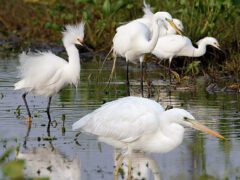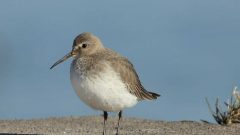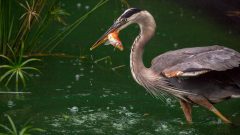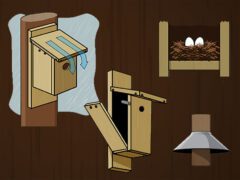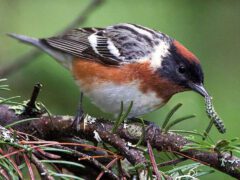Great Egret Similar Species Comparison
Main SpeciesGreat Egret
Adult
Long-legged wading bird with a long, S-curved neck and a daggerlike bill.
© Alex Lamoreaux / Macaulay LibraryPennsylvania, August 17, 2016Breeding adult (American)
"American" Great Egrets occur across much of North America and South America. Breeding adults have an orange-yellow bill and develop showy plumes (known as aigrettes) that they use in courtship displays.
© Darren Clark / Macaulay LibraryTexas, April 12, 2016Adult
Slowly walks through freshwater or estuarine habitats hunting foraging with stand-and-wait techniques.
© Eric Liner / Macaulay LibraryFlorida, January 18, 2009Breeding adult (African)
"African" Great Egrets are found in sub-Saharan Africa and Madagascar. Breeding adults have a black bill and blue-green lores between the bill and the eyes.
© Holger Teichmann / Macaulay LibraryKwazulu-Natal, January 14, 2017Breeding adult (alba)
Great Egrets breeding from central Europe to central Asia belong to the alba subspecies group. Breeding adults in this group have a blackish bill, greenish lores, and yellowish to reddish legs.
© Christoph Moning / Macaulay LibraryEmilia-Romagna, April 20, 2014Adult
Great Egrets are opportunistic foragers. They primarily consume fish, but also eat crustaceans, amphibians, and small mammals.
© Hannah Walker / Macaulay LibraryCalifornia, December 14, 2009Breeding adult (modesta)
Great Egrets breeding from South Asia and East Asia to Australia belong to the modesta subspecies group. Breeding adults in this group have a black bill, green lores, and dark legs with a pink or purplish wash.
© David Irving / Macaulay LibraryNew South Wales, November 28, 2020Adult
Flies with its long neck tucked in and its long legs trailing behind.
© Henry Gorski / Macaulay LibraryMissouri, August 27, 2020Breeding adult with Roseate Spoonbills
Males perform elegant courtship displays by raising long plumes on their backs. Displays also include head bowing or neck stretching.
© Larry Arbanas / Macaulay LibraryTexas, April 26, 2007Breeding adult (American)
Wades through water slowly stalking fish, amphibians, and other aquatic invertebrates.
© Evan Lipton / Macaulay LibraryMassachusetts, April 18, 2015Adult (with Snowy Egret)
"American" Great Egret is larger than a Snowy Egret, with a yellow bill and entirely black legs and feet.
© Chris McCreedy - no playbacks / Macaulay LibraryArizona, November 17, 2016Great Egrets while solitary foragers, roost and nest in mixed-species colonies in trees and shrubs.
© Larry Arbanas / Macaulay LibraryTexasHabitat
Found in both freshwater and saltwater wetlands.
© Jonathan Eckerson / Macaulay LibraryMassachusetts, December 21, 2016Similar SpeciesSnowy Egret
Adult
Snowy Egrets are smaller with a more slender bill than Great Egrets. Bill and feet color are the keys to separate them. Snowies have a black bill and yellow feet, whereas Great Egrets have a yellow bill and black feet.
© John Sutton / Macaulay LibraryFlorida, March 20, 2016Similar SpeciesGreat Blue Heron
Adult (white form)
White forms of Great Blue Herons look similar to Great Egrets but they are larger with a heftier bill. Great Blues also have head plumes (not always visible) that Great Egrets don't have.
© Alex Lamoreaux / Macaulay LibraryFlorida, May 18, 2012Similar SpeciesLittle Blue Heron
Juvenile
Juvenile Little Blue Herons are smaller with a thinner and darker, two-toned bill and greenish legs compared with Great Egrets.
© Zak Pohlen / Macaulay LibraryIdaho, October 26, 2015Similar SpeciesReddish Egret
Breeding adult white morph
White-morph Reddish Egrets are smaller than Great Egrets. Their shaggy-looking neck and pale, two-toned bill separate them from the smooth-necked and yellow-billed Great Egret.
© Jason Leifester / Macaulay LibraryTexas, April 20, 2017Similar SpeciesWood Stork
Adult
Wood Storks are larger than Great Egrets with a much longer and heavier bill. They have black primaries that are visible in flight, whereas Great Egrets are entirely white.
© Jim Sculatti / Macaulay LibraryTexas, June 17, 2017Compare with Similar Species
Click on an image to compare
Species in This Family
Herons, Egrets, and Bitterns(Order: Pelecaniformes, Family: Ardeidae)
More to Read
Don't miss a thing! Join our email list
The Cornell Lab will send you updates about birds,
birding, and opportunities to help bird conservation.















